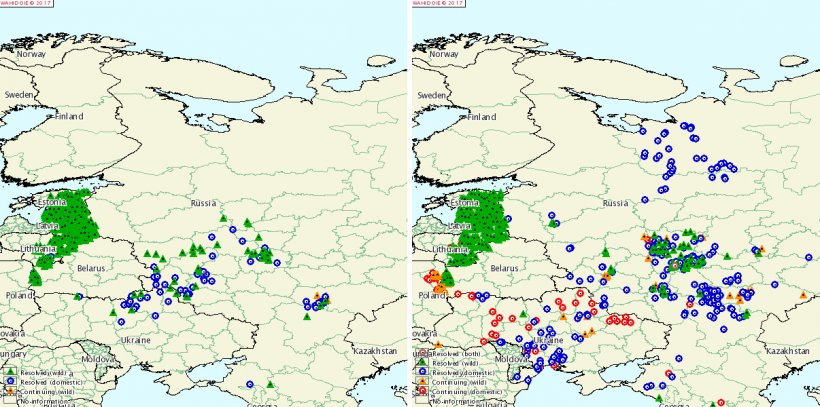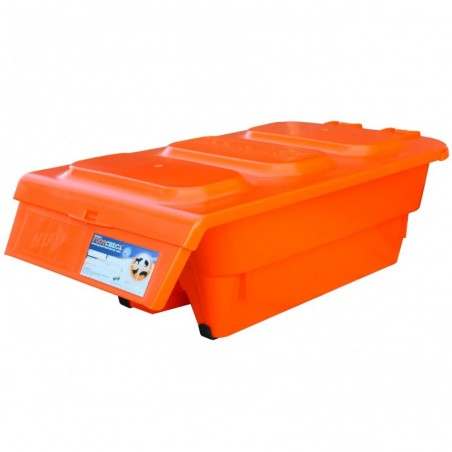The situation of African Swine Fever (ASF) in 2016 in Ukraine and Russia is still worrying because, as opposed to the EU countries, most of the detected outbreaks were confirmed in domestic pigs.
In the case of Ukraine, 82 outbreaks were detected in domestic pigs, doubling the number of outbreaks detected in 2015, that was 35, whilst there were 3 outbreaks in wild boars. We must highlight the confirmation of outbreaks on some very large commercial farms, as well as the spreading of the disease throughout all the territory. If in 2014 the affected provinces were only Lugansk, Chernigov and Sumy; in 2015 outbreaks were detected in Cherkassy, Chernigov, Kiev, Nikolayev, Odessa, Poltava, Rovno, Sumy and Zhitomir; whilst in 2016, the regions with outbreaks were Cherkassy, Chernigov, Chernovtsy, Zakarpats'ka, Khar'kov, Khmel'nitskiy, Kiev, Kirovograd, Nikolayev, Odessa, Poltava, Rovno, Sumy, Volyn, Vinnitsa and Zhitomir.

The outbreaks in wild boars detected near the borders with Romania on one hand, and with Slovakia on the other hand must be underlined.

Monthly evolution of the ASF outbreaks in Ukraine
In Russia, the increase in outbreaks in domestic pigs that affected, in some cases, large commercial pig farms during the summer months and in early autumn was spectacular, although they have decreased in the last months. During last year, 216 outbreaks were detected in pigs: almost 5 times more outbreaks than during the previous year (47 outbreaks in 2015). The number of outbreaks in wild boars (76 in total) almost doubles that of the previous year (44 outbreaks).

Monthly evolution of the ASF outbreaks in Russia
In Russia, as in Ukraine, the increase in the number of outbreaks is compounded by the spreading of the disease, with outbreaks confirmed in the north of the country, as it can be seen in the following maps of the WOAH:

ASF outbreaks in Russia and Ukraine in 2015 and 2016 1
In the EU, although most of the outbreaks appeared in wild boars, the total number of outbreaks has increased with respect to the previous years.
In Estonia and Latvia, although the disease persists in wild boars, the WOAH decided, last April, to not issue more monitoring reports of both countries due to the stability of the situation in domestic pigs, in which no outbreaks have been confirmed since September 2015, whilst in the case of wild boars, up to April 2016, 375 outbreaks had been recorded in Estonia and 267 in Latvia.
During 2016, both in Lithuania and Poland, the ASF outbreaks in pigs and wild boars increased with respect to 2015. Last year, Lithuania confirmed to the WOAH a total of 19 and 285 outbreaks in pigs and wild boars, respectively, versus the 13 and 107 outbreaks in 2015, and 6 and 41 in 2014. Although Poland had a lower number of outbreaks, it followed the same trend as Lithuania, in spite of the increase in the number of outbreaks in pigs during 2016 being significant (20 outbreaks in pigs and 81 in wild boars in 2016, versus 1 and 51 in 2015, and 1 and 30 in 2014).

Monthly evolution of the ASF outbreaks in Lithuania

Monthly evolution of the ASF outbreaks in Ukraine
We must say that during September, a first ASF outbreak was confirmed in Moldavia that affected pigs on a backyard farm. The origin was the use of food scraps to feed the animals. The WOAH considered that the case was solved in November.
January 2017/ 333's editorial department based on data from the WOAH.






